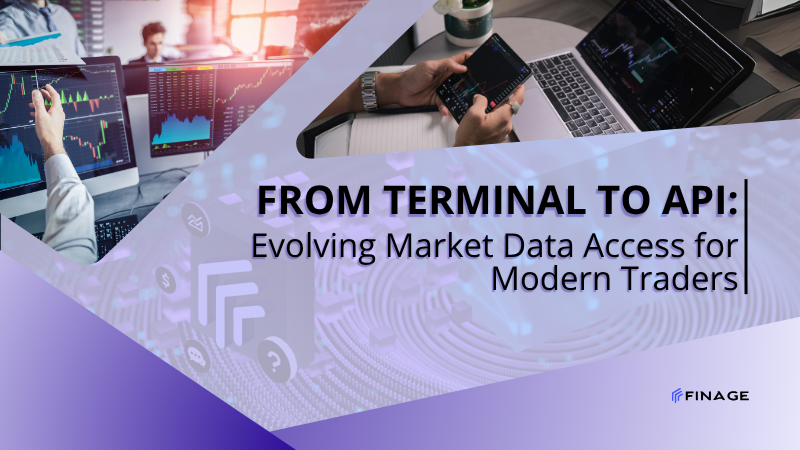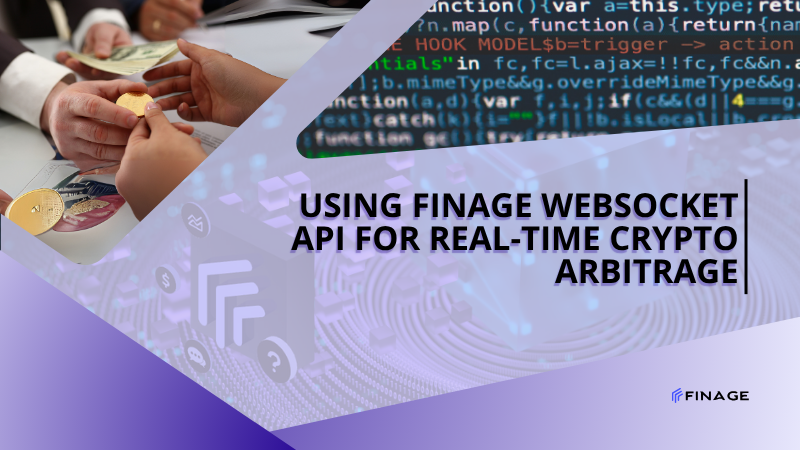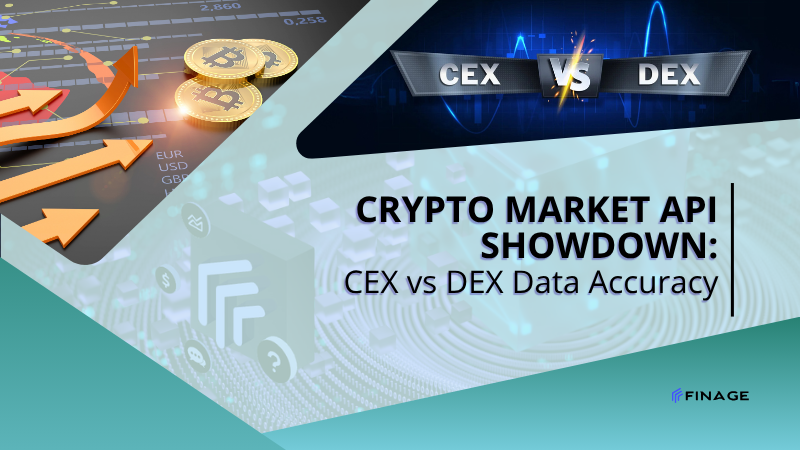From Terminal to API: Evolving Market Data Access for Modern Traders
9 min read • June 10, 2025

Introduction
Introduction
Market data has always been the backbone of trading. From the early days of ticker tapes and Bloomberg terminals to the latest WebSocket APIs and decentralized feeds, how traders access this information has radically transformed.
Today, modern traders — whether individual algo devs or institutional quant desks — demand faster, more flexible, and more programmable data pipelines. They want to move away from bulky terminals and vendor lock-ins, and instead build tools, bots, dashboards, and apps that process data autonomously and in real time.
In this blog, we’ll explore the evolution of market data access, why APIs are replacing terminals, and how you can use powerful data tools like those offered by Finage to build the next generation of trading systems.
Table of Contents
- The Evolution of Market Data Access: From Terminals to Cloud
- Why Traditional Terminals Fall Short in 2025
- What Modern Traders Need: Speed, Flexibility, and Automation
- REST vs WebSocket APIs: Which is Right for You?
- Integrating Market Data APIs into Custom Trading Systems
- Case Study: Using Finage APIs for Real-Time Market Access
- The Future of Market Data: Decentralized Feeds and AI Integration
- Final Thoughts: Unlocking a Terminal-Free Future with Finage
1. The Evolution of Market Data Access: From Terminals to Cloud
The way traders access market data has undergone a complete transformation in the past two decades — from manual terminals and human-readable screens to automated, real-time APIs that integrate seamlessly with algorithms, dashboards, and backend systems.
Let’s take a closer look at how this shift unfolded:
The Terminal Era: Static, Centralized Access
In the 1990s and early 2000s, platforms like Bloomberg, Reuters, and Eikon dominated market data access. These terminals offered:
- Real-time quotes and news feeds
- Charting and technical analysis tools
- Access to proprietary analytics
- Manual screen workflows for traders
While powerful, they were highly centralized, expensive, and non-programmable. Data could be viewed — not extracted or integrated into custom systems easily.
The Spreadsheet Phase: Semi-Programmable
Next came the use of spreadsheets (like Excel) with data plugins. Traders used VBA scripts, macros, and third-party connectors to pull market data into sheets.
It allowed some automation, but was still:
- Limited by local computing power
- Prone to crashing under large datasets
- Inefficient for real-time updates
The API Revolution: Full Integration and Real-Time Power
With the rise of REST and WebSocket APIs, market data became programmatically accessible. Traders could now:
- Fetch price data and OHLCV bars on-demand
- Stream live prices into bots and dashboards
- Integrate data with custom trading strategies
- Eliminate manual workflows entirely
This evolution is what powers today’s most successful fintech apps, HFT bots, and multi-asset trading systems — where speed, automation, and flexibility are non-negotiable.
2. Why Traditional Terminals Fall Short in 2025
Despite their legacy and prestige, traditional market data terminals are no longer enough for the needs of modern developers and tech-savvy traders. Here's why these tools — once the backbone of trading desks — are now seen as limited and outdated.
Closed Systems and Vendor Lock-In
Terminals are often built as walled gardens. While they offer powerful analytics, they make it hard — or expensive — to extract raw data. This lack of flexibility:
- Prevents developers from building automation pipelines
- Forces traders to use proprietary scripting tools instead of real programming languages
- Makes integrations with custom backends or AI tools difficult, if not impossible
Limited Real-Time Customization
Real-time updates in terminals are optimized for display, not programmatic use. If you want to:
- Stream tick data into a live chart in your app
- Trigger automated trades based on price thresholds
- Create real-time alerts across thousands of symbols
… you’re out of luck. APIs can do all of this — terminals cannot.
High Cost for Low Flexibility
Enterprise terminals can cost thousands of dollars per seat per year, even for basic access. For that price, users often get:
- Limited symbol coverage
- Restrictions on data redistribution
- No control over latency or data resolution
Meanwhile, APIs (especially from providers like Finage) offer affordable, scalable access to the same data — and more — via modern protocols.
Incompatibility with Modern Tech Stacks
Terminals were designed for human users, not systems. Today’s trading environments rely on:
- Docker containers and Kubernetes clusters
- JavaScript, Python, Node.js, and Go
- CI/CD pipelines, cloud functions, and serverless apps
You can’t plug a terminal into that — but you can plug an API into all of it.
3. What Modern Traders Need: Speed, Flexibility, and Automation
The new generation of traders — developers, quant analysts, and fintech builders — operate in a fundamentally different environment. They don’t want passive screens. They want data that can be acted upon, automated, and customized at scale.
Here’s what that looks like:
Real-Time Speed with Low Latency
Milliseconds can determine profits in high-frequency and algorithmic trading. Modern traders need:
- Live price updates via WebSocket instead of delayed refreshes
- Near-instantaneous access to order books and trade ticks
- Lightweight protocols optimized for latency-sensitive systems
Finage’s WebSocket APIs offer reliable low-latency streaming across multiple asset classes, tailored for these use cases.
Flexibility to Build Custom Tools
No two traders or firms use the same strategy or stack. That’s why the ability to:
- Query OHLCV data over custom intervals
- Subscribe to selected asset pairs dynamically
- Access crypto, stocks, forex, and indices in a unified format
… is essential. APIs give developers this flexibility — terminals do not.
End-to-End Automation
From idea to execution, traders want automation at every layer:
- Bots that adjust portfolios automatically
- Dashboards that alert when spreads widen
- Webhooks that trigger based on data thresholds
This level of control is only possible through programmatic APIs, not manual GUIs.
Developer-Centric Ecosystems
Modern platforms must offer:
- Clear API documentation
- Sandbox environments for testing
- Multiple SDKs and examples in Python, JavaScript, and more
- Transparent rate limits and response codes
Finage delivers all of this out of the box, enabling developers to move fast without friction.
4. REST vs WebSocket APIs: Which is Right for You?
When it comes to integrating market data, developers typically choose between REST and WebSocket APIs. Both are essential — but each serves different use cases. Understanding their strengths helps you design smarter, faster, and more resilient trading systems.
REST APIs: Reliable, Stateless, and Easy to Implement
REST APIs are perfect for:
- Historical data requests (e.g., OHLCV bars, last trades)
- Low-frequency updates (e.g., once-per-minute polling)
- Server-side integrations (e.g., dashboards, reporting systems)
Example request using Finage’s REST endpoint:
bash
GET https://api.finage.co.uk/agg/crypto/BTCUSD/1/minute/2024-06-01/2024-06-07?apikey=YOUR_API_KEY
Use REST when you want:
- Simplicity and wide compatibility
- Stateless transactions
- Fine control over query parameters
WebSocket APIs: Real-Time, Push-Based Streaming
WebSocket APIs allow live, bi-directional communication — perfect for:
- Real-time price updates
- Streaming order books or depth
- Low-latency algorithmic trading feeds
WebSockets shine when:
- Speed matters (e.g., HFT or arbitrage apps)
- You need event-driven architectures
- You’re building real-time UIs with instant data sync
Combining Both for Maximum Power
The most efficient setups use REST for historical context and WebSocket for real-time monitoring:
- Use REST to load chart data
- Use WebSocket to update the chart every second
- Use REST to place an order, and WebSocket to confirm it in real-time
This hybrid approach ensures data completeness and freshness at scale.
5. Integrating Market Data APIs into Custom Trading Systems
Once you’ve chosen your API type — REST, WebSocket, or both — the next step is actual integration. Whether you’re building a mobile trading app, a desktop dashboard, or a backend analytics service, modern APIs (like Finage’s) let you plug in real-time and historical data with minimal overhead.
Multi-Asset Aggregation
One of Finage’s strengths is supporting stocks, forex, crypto, indices, and ETFs from a unified API layer. You don’t need five different data vendors — just one API key and consistent symbol formatting.
This means your app can:
- Display cross-market comparisons
- Execute arbitrage strategies
- Offer a true multi-asset experience to users
6. Case Study: Using Finage APIs for Real-Time Market Access
Imagine you're building a full-stack trading dashboard for professional traders. The goal is to track stocks, crypto, and forex prices live, visualize historical trends, and send trade alerts — all without using traditional terminals. Each update includes bid, ask, and last price — giving traders an instant view of market movement. Your frontend can push this data into dynamic tickers, dashboards, or execution panels.
This gives you clean historical candlestick data — ideal for integration with libraries like ApexCharts, Highcharts, or custom-built charting engines.
Monitoring Forex Spreads in Real-Time
Finage offers low-latency forex data streams. Traders building spread strategies can track:
- Bid/ask movements
- Real-time spread widening or narrowing
- Volatility triggers
All from a single WebSocket session, without the need to license multiple expensive feeds.
7. The Future of Market Data: Decentralized Feeds and AI Integration
The evolution of market data doesn’t stop at APIs and dashboards. As we look beyond 2025, two forces are redefining how developers and traders interact with financial data: decentralization and artificial intelligence.
Decentralized Market Data Feeds
The rise of Web3 and DeFi has accelerated the demand for decentralized data. Instead of relying solely on centralized data vendors, developers are now pulling market prices from on-chain sources via oracle networks.
Emerging benefits include:
- Transparency: Data provenance is publicly verifiable on the blockchain
- Redundancy: No single point of failure
- Programmability: On-chain smart contracts can trigger directly from data events
While decentralized oracles still face challenges (latency, coverage), their role in the future of finance is growing. APIs that bridge both centralized and decentralized sources — like Finage — will have a key advantage.
AI-Powered Data Analysis
Beyond access, the real value of market data lies in making sense of it. AI is reshaping how traders interpret trends, detect anomalies, and generate insights. Key use cases include:
- Predictive models trained on historical OHLCV data
- NLP-powered sentiment feeds blended with real-time quotes
- ML algorithms detecting correlation shifts between asset pairs
These capabilities require APIs that are:
- Fast enough to feed real-time ML pipelines
- Structured enough to train reliable models
- Flexible enough to support custom workflows
Finage’s APIs are designed for this level of integration, making them ideal for AI-native trading systems and quant research stacks.
Unified Multi-Asset Infrastructure
Modern trading apps won’t be limited to “crypto-only” or “forex-only” anymore. The future lies in cross-asset applications — where one interface supports:
- Spot trading on crypto
- Option chains for equities
- Macro insights from forex and indices
APIs that offer a multi-market architecture (like Finage) will shape this unified landscape — enabling fintech builders to deliver seamless, high-performance trading experiences across global assets.
8. Final Thoughts: Unlocking a Terminal-Free Future with Finage
The world of trading is evolving — fast. Legacy terminals, closed data platforms, and inflexible workflows no longer meet the demands of modern traders and developers. Instead, the future belongs to real-time APIs, scalable systems, and customizable data access that adapts to your logic — not the other way around.
Whether you’re building a professional-grade trading bot, an AI-powered dashboard, or a multi-asset fintech app, the tools you choose will define your speed, scale, and success.
Finage is purpose-built for this future.
- Unified APIs across stocks, crypto, forex, indices, and ETFs
- Lightning-fast WebSocket and REST infrastructure
- Clean, reliable OHLCV and tick data
- Developer-first documentation and scalable pricing
By moving from terminal to API, you unlock control, automation, and the freedom to innovate. The future of trading isn't trapped behind a screen — it’s embedded in code, streamed in real time, and ready to power your next big product.
You can get your Real-Time and Historical Market Data with a free API key.
Build with us today!
Claim Your Free API Key Today
Access stock, forex and crypto market data with a free API key—no credit card required.

Stay Informed, Stay Ahead
Finage Blog: Data-Driven Insights & Ideas
Discover company news, announcements, updates, guides and more


